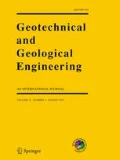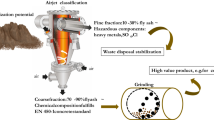Abstract
One of the effective utilization strategies for fly ash and waste sludge is to use it as a fill material to raise low lying areas. Bearing capacity and settlement are the required input for the design of foundations on such fills. To determine the bearing capacity, plate load tests were carried out on the compacted beds of fly ash, fly ash-waste sludge and fly ash-waste sludge–cement. The tests were conducted by keeping 90, 95 and 100 % relative compaction, fresh and fresh submerged conditions, aged (28 days) and aged (28 days) submerged conditions as variables of the tests. The load-settlement curves were plotted for fly ash and mix blends. The minimum load was obtained for fly ash under submerged condition, further the test results show that the fly ash becomes flowable on submergence. On the other hand when the fly ash was mixed with waste sludge and cement, the load carrying capacity was found to improve to a greater extent. Test beds prepared with fly ash–cement-waste sludge under as compacted condition (fresh) show very high load carrying capacity (1600–2180 kN/m2). An analytical method has also been validated for fly ash–cement-waste sludge mix which was developed to estimate the settlement of footing resting on fly ash taking into account the pre-consolidation stresses. The non linearity of load-settlement behavior was appropriately modeled, on the basis of available plate load test data incorporated in the method. The method requires as input, the pre-consolidation stress and Young’s modulus of compacted mix of fly ash-waste sludge–cement. A comparison of load-settlement values observed in plate load tests and predicted values for the mix 47 %FA + 45 %S + 8 %C, using the proposed method shows good agreement. Hence, this relationship may also be useful to the field engineers to check the reported load-settlement values for such types of mixes in the field.























Similar content being viewed by others
References
Agarwal A (2001) Water pollution: problems posed by small industry a case study of India and China. Stockholm Water Symposium, Stockholm
Ahmad MS, Shah SS (2010) Load bearing strength of fly ash modified with cement and waste sludge. Int J Civil Eng 8(4):315–326
Akhter H, Butler LG, Branz S, Cartledge FK, Tittlebaum ME (1990) Immobilization of As, Cd, Cr and Pb containing soils by using cement or pozzolanic fixing agents. J Hazard Mater 24:145–155
Al-Amoudi OSB (2002) Characterization and chemical stabilization of Al-Qurayyah Sabkha soil. J Mater Civ Eng 14(6):478–484
ASTM D 1194-94 (1998) Standard test method for bearing capacity of soil for static load and spread footings, Philadelphia, USA
ASTM D 2487 (2000) Standard classification of soils for engineering purposes, Philadelphia, USA
ASTM C 150 (2012) Standard specification for Portland cement, Philadelphia, USA
ASTM D 698 (2000). Standard test methods for laboratory compaction characteristics of soil using standard effort. Philadelphia, USA
Becker DE, Crooks JHA, Been K, Jefferies MG (1987) Work as a criterion for determining in situ and yield stresses in clays. Can Geotech J 24:549–564
Bobe R, Pietsch C (1981) Settlement calculation by a new strength theory. X Int Conf Soil Mech Found Eng Stockholm 1:53–56
Burland JB (1990) On the compressibility and shear strength of natural clays. Geotechnique 40:329–378
Conner JR (1990) Chemical fixation and solidification of hazardous waste. Van Nostrand Reinhold, New York
Consoli NC, Casagrande MDT, Prietto PDM, Thome A (2003) Plate load test on fiber-reinforced soil. J Geotech Geoenviron Eng ASCE 129(10):951–955
Dayal U, Sinha R (2000) Technology demonstration of structural filling of ash. In: 2nd international conference on fly ash disposal and utilization, CBIP, New Delhi, pp 43–50
Foundations—Static loading tests (1991) Brazilian Standards NBR-12131. Brazilian Association of Technical Standards, Rio de Janeiro
Ghosh A, Bhatnagar JM (1998) Reclmation of abandoned fly ash pond for human settlement. Indian Geotechnical Conference, New Delhi, pp 367–370
Ghosh A, Subbarao C (2007) Strength characteristics of Class F fly ash modified with lime and gypsum. J Geotech Geoenviron Eng 133(7):757–766
Grozic JLH, Lunne T, Pande S (2003) An odometer test study on the preconsolidation stress of Glaciomarine clays. Can Geotech J 40:857–872
Guo T, Malone RF, Rusch KR (2001) Stabilized phosphogypsum: class C fly ash: Portland type II cement composites for potential marine application. Environ Sci Technol 35:3967–3973
Humphrey DN, Whethen N, Weaver J, Recker K, Cosgrove TA (1998) Tire shreds as lightweight fills for embankment and retaining walls. ASCE Geotech Special Publ 79:230
Indraratna B, Nutalaya P, Koo KS, Kuganenthira N (1991) Engineering behaviour of low carbon, pozzolanic fly ash and its potential as a construction fill. Can Geotech J 28:542–555
Lange LC, Hills CD, Poole AB (1996) The effect of accelerated carbonation on the properties of cement solidified waste forms. Waste Manag 16:757–763
Leonards GA, Bailey B (1982) Pulverized coal ash as structural fill. J Soil Mech Found Div 108:517–531
Nathalie M, Drogui P, Montan C, Hausler R, Mercier G, Blais J-F (2006) Comparison between electrocoagulation and chemical precipitation for metals removal from acidic soil leachate. J Hazard Mater B 137:581–590
Onitsuka K, Hong Z, Hara Y, Yoshitake S (1995) Interpretation of odometer test data for normal clays. Soils Found 35:61–70
Osinubi KJ, Nwaiwu MO (2006) Compaction delay effects on properties of lime-treated soil. J Hazard Mater 18(2):250–258
Parsa J, Stuart H, McGee M, Steiner R (1996) Stabilization/solidification of hazardous wastes using fly ash. J Environ Eng 122(10):935–939
Peck RB, Hansen WE, Thornburn TH (1974) Foundation engineering. Wiley, New York, pp 193–199
Poudel RK (1990) Effect of capillarity on the behaviour of test plates on sands. Ph.D. Thesis, Department of Civil Engineering, University of Roorkee, Roorkee
Ramasamy G, Pusadkar SS (2007) Settlement of footing on compacted ash bed. J Geotech Geoenviron Eng 133(11):1462–1465
Ramasamy G, Poudal RK, Ranjan G (1999) Estimation of settlements of footings from load tests on capillary sand beds. Indian Geotech J 29(4):362–372
Roy A, Eaton HC, Cartledge FK, Tittlebaum ME (1991) Solidification/stabilization of heavy metal sludge by a Portland cement/fly ash binding mixture hazard. Waste Hazard Mater 8:33–39
Schmertmann JH, Hartman JP, Brown PR (1978) Improved influence factors diagrams. J Geotech Eng Div 104(8):1131–1135
Shah SS, Ahmad MS (2008) Stabilization of heavy metal containing waste using fly ash and cement. Indian Geotechn J 38(1):89–100
Skarzynska KM, Rainbow AKM (1989) Characteristics of coal ash in storage pond. XII ICSMFE, Balkema, pp 1915–1918
Sophia CA, Swaminathan K (2005) Assessment of the mechanical stability and chemical leachability of immobilized electroplating waste. Chemosphere 58:75–82
Toth PS, Chan HT, Cragg CB (1988) Coal ash as structural fill with special reference to Ontario experience. Can Geotech J 25:694–704
Turkel S (2006) Long-term compressive strength and some other properties of controlled low strength materials made with pozzolanic cement and Class C fly ash. J Hazard Mater B 137:261–266
Weng CH, Huang CP (1994) Treatment of metal industrial waste water by fly ash and cement fixation. J Environ Eng 120(6):1470–1487
Wiki Answers (2006) http://dqindia.ciol.com/content/top_stories/2006
Author information
Authors and Affiliations
Corresponding author
Rights and permissions
About this article
Cite this article
Ahmad, M.S., Shah, S.S. Load Settlement Behaviour of Fly ash Mixed with Waste Sludge and Cement. Geotech Geol Eng 34, 37–58 (2016). https://doi.org/10.1007/s10706-015-9927-z
Received:
Accepted:
Published:
Issue Date:
DOI: https://doi.org/10.1007/s10706-015-9927-z




